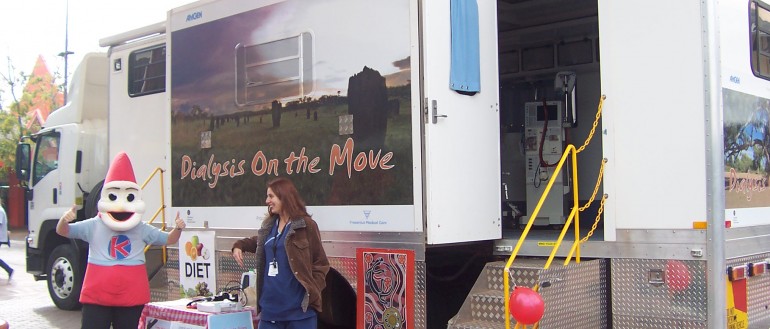Dialysis Models of Care: A partnership project to examine the costs and outcomes of different dialysis models and proximity to home
Aims:
To better understand how different dialysis treatment models impact on patients, families and other service providers, to determine the full range of associated outcomes and costs.
Objectives:
- To better understand how current patterns of dialysis provision that require relocation to urban centres to access treatment, impact on the health, social and cultural needs of Indigenous renal patients, their families and community.
- To determine the impact of models on other government and non-government services and organisations in both urban and remote areas.
- To determine the costs and benefits of each model of care that goes beyond the health delivery costs of renal treatments.
- To develop a value for money rubric with stakeholders to provide a cost and benefit analysis that is easily interpreted, generally understandable and accessible to all stakeholders.
- To ensure integration of our research findings into health policy and renal service delivery.
Summary:
Rates of kidney disease in the Northern Territory (NT) are highest among Aboriginal and Torres Strait Islander people living in remote communities where access to dialysis treatments is limited. We know that relocation for dialysis has profound health, social and economic consequences, but these consequences have previously not been well described or quantified.
This partnership project will improve understanding of the health, social and economic impacts of the five most common types of dialysis services (called models of care - MoC) available in the NT: urban satellite dialysis; regional satellite dialysis; rural/remote satellite dialysis; supported home and community-based dialysis; and self-care dialysis.
This project has collected and analysed data from health, housing and education. Importantly, patients, carers and Aboriginal and Torres Strait Islander co-researchers have been engaged in the process throughout the project and have informed many of the findings.
We have explored the costs and outcomes associated with each MoC, with a focus on:
- Health costs not directly tied to dialysis treatments, including hospital admissions and emergency presentations
- Costs associated with facility dialysis including direct and indirect costs, infrastructure and costs associated with relocations including training, travel and staff accommodation
- Broader government impacts such as housing utilisation, social supports and impact on the education system
- Impacts on the patient of different MoC including loss of employment, psychological and physical impact of relocation, and maintaining links with family and community
- Exploring what makes a good life for Aboriginal and Torres Strait Islander people and what makes a good life on dialysis
- The impact on school attendance and educational outcomes of children with a parent on dialysis.
Building on the existing relationships in the Dialysis Models of Care Partnership and, most importantly, responding to a request from the Aboriginal community-based researchers within NPY Women’s council and Purple House, “Making Sense and Informing Action” research project is now underway. This study aims to engage with stakeholders including Aboriginal renal patients and community members to inform their communities about understandings of the social and economic costs of dialysis. Thus, leading to decision-making shaped by community understanding and perspectives in relation to establishing community-based dialysis.
Implications for policy and practice:
This project will provide comprehensive information on the broader costs and outcomes of the different DxMoC. Through our partners and collaborators our research findings will be integrated into health policy and service delivery. We aim to provide an evidence base for cost-effective dialysis that considers the needs of patients and their families, and better delivers accessible and patient-centred care.
Chief investigator:
Project manager and contact:
Project dates:
November 2014 - November 2020
-
2017 Information brochure
- 683 kB
-
Database of cross-cultural awareness programs NT - February 2017
- 773 kB
-
Cross-cultural report - February 2017
- 697 kB
-
Dialysis Models of Care newsletter - March 2017
- 561 kB
-
PAR Project progress report - 17 February 2017
- 620 kB
-
Progress Report - September 2016
- 703 kB
-
Progress Report - 15th July 2015
- 281 kB
Please click here to be taken to the Dx MoC Investigators Portal.
Funders:
Collaborators:
Videos
- Gorham G, Howard K, Togni S, Lawton P, Hughes J, Majoni W, Brown S, Barnes S, Cass A. Economic and quality of care evaluation of dialysis service models in remote Australia: protocol for a mixed methods study. BMC Health Services Research 2017; 17:320 DOI 10.1186/s12913-017-2273-5.
- Gorham G, Majoni W, Lawton P, Brown S, Dube B, Conlon T, Cherian S, Wood P, Signal S, Cass A. Interesting times: evolution of dialysis in Australia’s Northern Territory (1980 – 2014). Renal Society of Australasia Journal 2018; 14 (3): 108-16.
- Gorham G, Howard K, Zhao Y, Ahmed S, Lawton P; Sajiv C, Majoni W, Wood P, Conlon T, Robinson S, Signal S, Brown S, Cass A. Cost of dialysis therapies in rural and remote Australia – a micro-costing analysis. BMC Nephrology 2019; 20 (1): Article number 231.
- Gorham G, Howard K, Cunningham J, Barzi F, Lawton P, Cass A. Do remote dialysis services really cost more? An economic analysis of hospital and dialysis modality costs associated with dialysis services in urban, rural and remote settings. BMC Health Services Research 2021; 21 (1): Article No 582.
- Gorham G, Howard K, Cunningham J, Lawton P, Ahmed S, Barzi F, Cass A. Dialysis attendance patterns and health care utilisation of Aboriginal patients attending dialysis services in urban, rural and remote locations. BMC Health Services Research 2022; Article No. 251.

